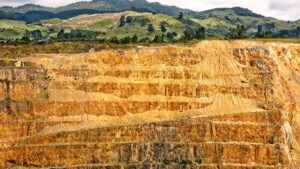Tim Treadgold: Nickel Mines keeps on winning

Pic: Bloomberg Creative / Bloomberg Creative Photos via Getty Images
When you’re on a good thing stick to it!
Advice once used to sell fly spray, but in today’s world of investing it’s about finding a good stock and riding it up, up and up — which is the case with Nickel Mines (ASX:NIC) which remains hard to ignore even after a stellar year.
First featured on Stockhead in late January when it was limping along at 28c, Nickel Mines moved up to 42c in our second detailed look in mid-April, and is currently trading around 73c.
But that’s not the end of the story about a company which has deviated from the normal course of Australian nickel stocks to take a position in the heart of a rival as the supplier of part-processed material to a Chinese steel mill in Indonesia.
The unusual nature of the Nickel Mines’ business model means that it has not attracted mainstream media interest in Australia.
But that’s a problem for people ignoring the company, not for investors who recognised early that value can sometimes be created by being a little bit different.
In the case of Nickel Mines, that means either continuing the ride up, or joining the game because the stock has just been set a new price target by analysts at Bell Potter who reckon $1.24 is in sight – up from their last price forecast of 94c.
Sticking with Nickel Mines is a case of applying the original “stick with it” slogan used to sell Mortein in the 1960s before it switched to Louie the Fly, because the financial numbers in the latest Bell Potter research are more than attractive.
According to the broker, Nickel Mines will blitz its maiden profit of $7.2m achieved in the year to June 30 by posting earnings of $154m in the current financial year, rising next year to $191m.
In simple terms, Nickel Mines is exceeding all its promises as it rides the high nickel price and strong demand from the Chinese operated stainless steel mill at Morowali Industrial park on the Indonesia island of Sulawesi.
“Nickel Mines 2019 financial result came in ahead of our expectations, delivering a maiden underlying net profit after tax of $7.2m,” Bell Potter said.
“While modest, it was ahead of our forecast of a minor loss and was generated during the ramp up and commissioning phase at Morowali.”
Unlike conventional nickel producers such as those operating mines in Australia, the Nickel Mines’ business is based on large reserves of low-grade laterite (near-surface) ore which is fed directly into a rotary kiln electric furnace (RKEF) to yield a material call nickel pig iron (NPI).
The NPI is then delivered directly to the steel mill operated by Chinese stainless-steel specialist Tsingshan which is producing the world’s lowest-cost stainless at Morowali – so low that the Chinese government has imposed a tariff on material delivered to China by a Chinese company.
The involvement of Nickel Mines only goes as far as majority ownership of two “lines” of kilns. The original line is called Hengjaya and the latest is called Ranger. Both lines are 60 percent owned by Nickel Mines.
Bell Potter said that monthly production data included in an update presentation recently released to the market has shown continued ramp-up success across both the Hengjaya and Ranger lines.
“The upshot is that the combined NPI production from the Hengjaya and Ranger lines has comfortably exceeded our ramp-up forecasts and our modelled, steady-state production has been reached one month ahead of an already accelerated schedule,” the broker said.
Higher nickel grades in the NPI are believed to be a factor in the better-than-expected performance of the project, which is forecast to operate at an annualised production rate of close to 40,000 tonnes of nickel in NPI.
That equates to a Nickel Mines share of up to 24,000 tonnes a year of nickel in NPI.
To put that amount of nickel into perspective, it is slightly more than last financial year’s output by one of the leading Australian-based pure-play, Western Areas (ASX:WSA), which produced 21,675 tonnes of nickel in concentrate.
But it’s at a financial level where the two companies part, with Nickel Mines enjoying the benefit of having a captive customer at its doorstep taking all the NPI produced for use in stainless steel production, whereas Western Areas is more exposed to the global market.
The stock market is another place where Nickel Mines and Western Areas differ, with investors slowly becoming aware of the fat profit margins being generated in the production of NPI from easy-to-mine laterite ores compared with Western Areas’ exposure to deep, hard-rock mining in WA.
Despite producing a similar amount of nickel, Western Areas has a stock-market value of around $870m, less than half Nickel Mines which has a market capitalisation of $1.23 billion.
Perhaps more interesting is that if Bell Potter’s $1.24 price tip proves to be correct Nickel Mines could soon be worth more than $2 billion given its 1.66 billion issued shares.
If the stock reaches $2 billion it would also be knocking on the door of a place in the ASX top 150, a level which might, somewhat sadly, elevate it beyond the small-to-mid tier focus of Stockhead.
When you’re on a good thing stick to it – and we have done just that.
READ MORE:
Tim Treadgold: Nickel on the move – ‘buy the sector’
Tim Treadgold: Nickel marches higher, the sector remains a buy (for now!)
Tim Treadgold: Nickel Mines carves out a slice of the Indonesian nickel business
UNLOCK INSIGHTS
Discover the untold stories of emerging ASX stocks.
Daily news and expert analysis, it's free to subscribe.
By proceeding, you confirm you understand that we handle personal information in accordance with our Privacy Policy.








